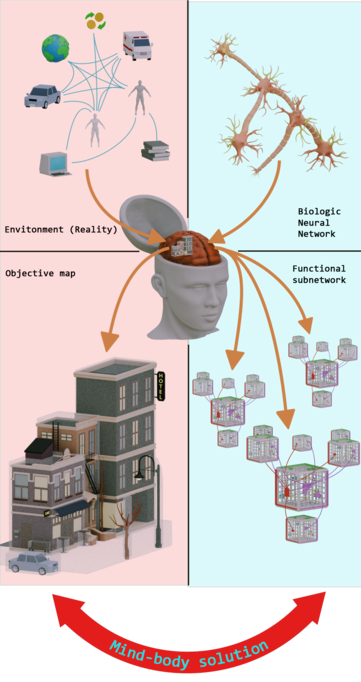GTOM: Difference between revisions
No edit summary Tags: Manual revert Visual edit |
|||
| (65 intermediate revisions by 2 users not shown) | |||
| Line 1: | Line 1: | ||
[[File:GTOM mod 2.png|left|683x683px|Gativus assumes that subjective reality consists of an object map and functional sub-systems]] | |||
Gativus | |||
=== | === Gativus Theory of Mind and Consciousness (GTOM) === | ||
<hr> | |||
'''Gativus''' solves the [[wikipedia:Mind–body_problem|Mind-Body]] problem by considering it from engineering point of view, i.e. that both the Mind and the Body have to be networks. | |||
''' | The '''''"Body"''''' network is based on cellular tissue of neurons and is comprised of numerous sub-networks, such as hippocampus, cerebellum, etc, as well as various fields of cortex. But all of them have technical background and would be implemented not only as biological, but also as electronic device. | ||
The '''''"Mind"''''' network is based on knowledge entities as a main construction block, as well as corresponding tools for their creation and manipulation. This network traditionally associated with human psyche. | |||
Both networks has primary target to ensure survival of the organism as individual and as kind. | |||
As soon as both components of the Mind-Body problem are networks, they can be represented as set of nodes and their relations. Gativus defines node as identified entity with unique name and numerous components gathered into groups by their distinctive properties, such as value storage, activity, etc. Every component may have a connection points for establishing relations, which are specific for each group of components. Gativus node notation is described in Gativus Notation (GNOT). | |||
''' | '''Gativus''' is based on ''<u>Axiom</u>'' that '''both networks have physical interconnection''', what means that there are relations between knowledge entities and neuron level cells. | ||
<div></div> | |||
=== Next article === | |||
<hr> | |||
[[GTOM2 |'''Structure''' of Gativus Theory of Mind and Consciousness (GTOM)]] | |||
=== | |||
< | |||
''' | |||
Latest revision as of 03:01, 16 February 2025
Gativus Theory of Mind and Consciousness (GTOM)
Gativus solves the Mind-Body problem by considering it from engineering point of view, i.e. that both the Mind and the Body have to be networks.
The "Body" network is based on cellular tissue of neurons and is comprised of numerous sub-networks, such as hippocampus, cerebellum, etc, as well as various fields of cortex. But all of them have technical background and would be implemented not only as biological, but also as electronic device.
The "Mind" network is based on knowledge entities as a main construction block, as well as corresponding tools for their creation and manipulation. This network traditionally associated with human psyche.
Both networks has primary target to ensure survival of the organism as individual and as kind.
As soon as both components of the Mind-Body problem are networks, they can be represented as set of nodes and their relations. Gativus defines node as identified entity with unique name and numerous components gathered into groups by their distinctive properties, such as value storage, activity, etc. Every component may have a connection points for establishing relations, which are specific for each group of components. Gativus node notation is described in Gativus Notation (GNOT).
Gativus is based on Axiom that both networks have physical interconnection, what means that there are relations between knowledge entities and neuron level cells.
Next article
Structure of Gativus Theory of Mind and Consciousness (GTOM)
